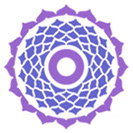Seven Energy Centers of Human Energy Field (Chakras)
Here are the descriptions of the main human energy centers: location, color, related body parts, and functions.
The First — Root Chakra (Muladhara)

Location: Base of the spinal cord.
Color: Red.
Element: Earth.
Sense: Smell.
Related Body Parts: Lymph, skeleton, prostate, large intestine, rectum, legs, and adrenals.
The root chakra is responsible for feeling safety and connection with the earth and material plane. It's the center of life energy related to the instinct of survival and equilibrium. Every human has a body and instincts similar to animals. Root chakra controls the needs for food, personal safety, and material shelter.
When their root chakra is well-balanced, a person is courageous, strong-willed, and self-confident. Otherwise, one either feels a lack of energy, fear, and low self-esteem or becomes aggressive and self-centered.
The Second — Sacral Chakra (Svadhisthana)

Location: 2 inches below the navel.
Color: Orange.
Element: Water.
Sense: Taste, appetite.
Related Body Parts: Ovaries, testicles, urinary tract.
The sacral chakra controls sexual desire, procreation, and emotions. The proper functioning of the sacral chakra determines the ability to have a baby, positive emotions, and personal relations. In terms of the first chakra, it's sufficient to survive in the surrounding environment, whereas the second chakra impels one to seek pleasure and emotional fulfillment in life.
When the sacral chakra is well-balanced, one feels sociable, creative, independent, and joyful. If this chakra is dysfunctional, a person becomes too dependent on others, destructive, reserved, and dissatisfied.
The Third — Solar Plexus Chakra (Manipura)

Location: Between the lower ribs.
Color: Yellow.
Element: Fire.
Sense: Seeing.
Related Body Parts: Muscles, skin, stomach, liver, eyes, and other organs near the solar plexus.
Solar plexus chakra is the center of personal willpower. It relates to one's ego and self-esteem and represents strength and the inclination to control the course of events. The third chakra is responsible for our choices and beliefs, which we are ready to defend. As well as for composure, inner discipline, and professional advancement.
When solar plexus chakra functions well, it evokes confidence, optimism, buoyancy, and a good mood. Disorders of this chakra lead to pessimism, isolation, overthinking matters, and lack of self-respect.
The Fourth — Heart Chakra (Anahata)

Location: Center of the chest.
Color: Green.
Element: Air.
Sense: Touch.
Related Body Parts: Heart and circulation of the blood, lungs, and chest.
The Heart Chakra is associated with the capacity to love and sympathize with other beings. When someone follows their heart, he or she becomes full of warmth and joy. Love is above any rational calculations regarding survival and strengthening one's position. This chakra also coordinates artistic expression and healing potential.
As long as their heart chakra is balanced and open, a person is loving, harmonious, generous, and compassionate. Otherwise, greed, cynicism, iciness, and envy may manifest.
The Fifth — Throat Chakra (Vishuddha)

Location: Base of the throat.
Color: Blue.
Element: Ether, space.
Sense: Hearing.
Related Body Parts: Throat, ears, tongue, thyroid gland, and hands.
The throat chakra is responsible for communication, verbal expression, and musical talent. Personal uniqueness, creativity, and the inner voice of truth lie in this chakra. It allows one to contribute to society through innovative ideas.
When the throat chakra is well-balanced, one is serene, tactful, peaceful, and benevolent. If closed or imbalanced, dishonesty, infidelity, lawlessness, and emotional cruelty may manifest.
The Sixth — Third Eye Chakra (Ajna)

Location: Between the eyebrows.
Color: Indigo.
Sense: Extrasensory perception.
Related Body Parts: Forehead, temples, pineal gland, pituitary gland, and carotid.
Third Eye Chakra controls imagination, visual thinking, spiritual wisdom, and intuition. It's related to being responsible for oneself and realizing the divine nature of all phenomena. The sixth chakra is transcendental. Therefore, it allows recognizing the existence beyond material forms and ordinary senses.
When the Third Eye chakra is well-balanced, one's intuition is strong, and thinking is orderly and consistent. If this chakra malfunctions, thoughts may turn chaotic, and one may stop trusting his or her intuition and start living in an imaginary world.
The Seventh — Crown Chakra (Sahasrara)

Location: Top of the head.
Color: Purple or white.
Sense: Unity with the universe and spiritual harmony.
Related Body Parts: Brain and central nervous system.
The crown chakra is beyond the duality of subject and object, the perception of "I "and "mine." It implies total boundless unity, an eternity in the instant presence. Words or mental concepts are incapable of conveying this wisdom. Crown chakra represents spiritual knowledge and pure cosmic energy.
While functioning correctly allows one to be idealistic, find the right path to attain spiritual wisdom, and respect all sentient beings. When Crown chakra is blocked, one considers him or herself better than others, loses connection with their spiritual self, and their outlook becomes grossly materialistic.
